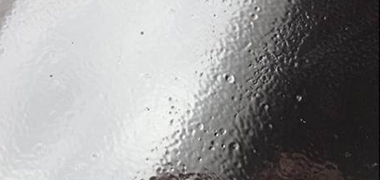Nolifrit Analyze the Solution for Dimple Defect
From April to October each year, especially in the high temperature season, when the temperature of the place exceeds 30 ° C, some enamel factories often produces ground coat with dimple defect (commonly known as crystals and white spots) after firing. This kind of dimple is different from the ordinary pitting defects, with a black protruding particle in the center and a milky white oil mist-like ground coat layer around it. This kind of ground coat defect seriously endangers the quality of the product, because the enamel surface will inevitably appear a large number of bubbles or pinhole and black spots when the cover coat is fired. What's more troublesome is that after decal or printing processing, the quality situation worsens.
Some information and data show that this defect has seriously disturbed the normal production of some enamel factories in the high temperature season for many years. At this time, the quality of the product is greatly reduced, the normal production order is disrupted, and sometimes only to wait for the high temperature season to pass. When the autumn and winter comes, the defects disappear automatically. Year after year, the reason and theory of this dimple defect are studied and explored, and a more thorough solution is researched on this basis, which has great practical significance for many enamel factories.

Antimony oxide is the core cause of the dimple defect.
The result of research shows that the core cause of the problem is Antimony oxide. Although the aggregation process is affected by environmental conditions such as temperature, concentration, and pH, if there is no Antimony oxide aggregation core, such milky white aggregates cannot be produced, and oil mist-like pits will not caused, which provides a direction for eradicating such defect. In the past, our enamel workers tended to focus on studying and improving the external environmental conditions of this gathering process, and less on the essential factors of their gathering core.
So, how does the oil mist-like pits form?
During the firing process of the ground coat, the Antimony oxide aggregates with a sufficiently large particle size will contact the hot steel substrate and undergo the following chemical reaction:
Sb203 + Fe ------ Fe2O3 + Sb (black protruding particles)
Nolifrit experiments confirmed that the black protruding particles in the center of the oil mist-like pits after firing the ground coat are good conductors (resistance is only a few ohms, is a metal substance, specifically its main component is antimony. The creamy white oil mist ground coat is caused by the coloration of Antimony oxide when it is partially melted into the ground coat glass body.
Necessity of Antimony oxide as milling additive and other alternatives.
As mentioned above, without Antimony oxide, the oil mist-like dimple defects can completely solved, so the necessity of Antimony oxide as milling additive must be discussed
Antimony oxide in the ground coat is the adhesion promotion method adopted by most enamel factories in China. Its price is lower and it has a better adhesion promotion effect. By adding 1.0 ~ 1.5% Antimony oxide to Nickel ground coat frit, Antimony Molybdenum ground coat frit, it can increase the adhesion ability of half to one grade. This has also been proven over the years by numerous production practices. Therefore, in general, the method of grinding with Antimony oxide is effective and economical, but it is not necessary or a must. We are encountering this situation here and need solutions or alternatives to replace Antimony oxide.
The main solutions are follows:
1. Grind with Sodium Antimonate. Grind 1.0% ~ 1.5% of Sodium Antimony in Nickel ground coat. The ground coat has a good enamel surface, and the adhesion ability is increased by one level to reach the level of silk. Sodium Antimonate can be marketed or made by yourself, but its alkalinity must be controlled, otherwise it will affect the performance of enamel slip.
2. Grind with Sodium Antimonate and Barium Molybdate. Some researchers have proposed that when Barium Molybdate and Sodium Antimonate are mixed at a ratio of 1: 2, when 0.5% by weight is added to Nickel ground coat, the adhesion can be increased by 18%, and the firing range expend by 60%.
3. In recent years, studies have shown that grinding the rare earth can make the enamel ground coat fully dissolve the basic metal oxides during firing, control the diffusion in the oxide film on the surface of the adhesive, and improve the adhesion strength of the enamel.
4. Preliminary tests have shown that grinding Nickel oxide can increase the efficiency of adhesion and help to overcome fish scale defects.
5. Change the formula of enamel ground coat. For example, the use of ingredients containing a certain amount of Barium oxide to improve the wettability of the enamel ground coat can also help to improve adhesion.
6. In the firing process, certain strengthening measures are taken to improve the adhesion ability.